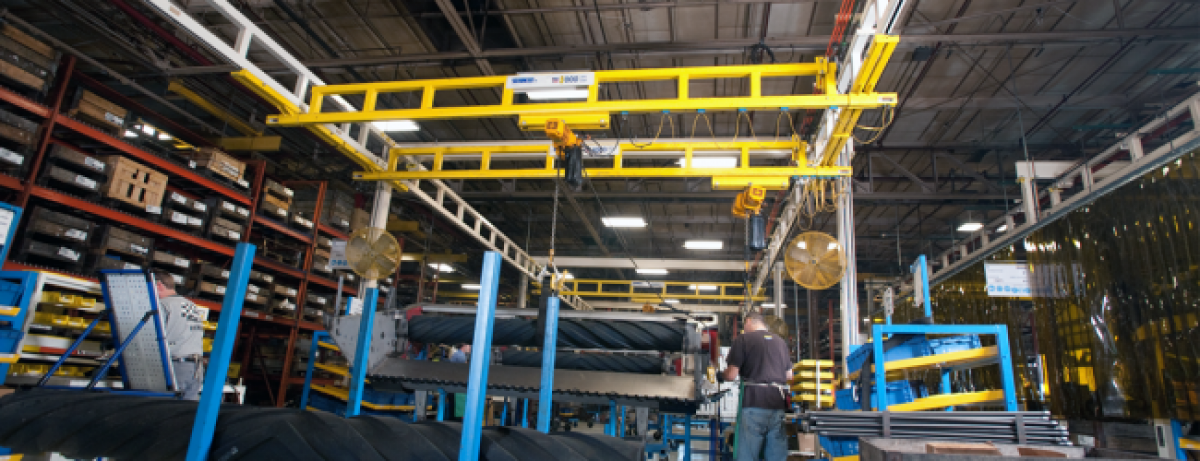Related: Bridge Cranes, Gantry Cranes and Jib Cranes
Often times one of the best ways to transport products throughout a warehouse facility is through lifting it up and moving it overhead. By handing products and materials overhead you can help to increase productivity, enhance worker safety and increase the amount of available floor space.
With many different types of overhead material handling equipment ranging from wall mounted jib cranes to double girder top running cranes, it can understandably be a little overwhelming to even approach the idea of implementing a crane within your workplace.
Though a good thing to know is that all overhead material handling equipment shares the same common goal, to lift items up efficiently, ergonomically and safely and move it from one location to another without causing any damage to the product, workers or facility.
Though this particular blog will be focusing on the workstation bridge crane, and just like past blogs about jib cranes and gantry cranes we will give you a general overview as to what they are and how you can implement them into the workplace.
Workstation cranes when on a smaller scale are often freestanding workstation cranes, which enable their operators to work within a cell unit safety as they manoeuvre light loads. These freestanding units help to improve upon the ergonomic handling of products within a limited area, creating a production environment.
The latest technology within workstation cranes has created intelligent devices, which combine manual and servo-driven operations. The servo-driven part of the crane controls the positioning of the machine, while the manual function allows the worker to operate at his or her own speed. There are several types of cranes, which can be used as a workstation crane including the following:
Gantry Cranes:
Gantry cranes are made of two uprights, which are connected by an I-beam, which serves as the bridge for the trolley. Gantry cranes can be either manual or powered.
Powered: The uprights run on a track system on the floor level. Though in a lighter-duty crane, the uprights will be on wheels, which can be manually positioned and repositioned throughout the facility.
Manual: This means the operator directs were the crane moves and at what speed.
Gantry cranes have a load capacity of up to 5 tonnes and spans that can reach up to 30 feet, which is why they are most commonly used in maintenance operations. They are an extremely cost-effective solution for many applications, which require infrequent usage.
Jib Cranes:
These cranes are often used for spot handling. Jib cranes include a single bridge that rotates to cover a circular area. Because the jib crane rotates, this allows for the loads to easily move into position. These cranes are often used in conjunction with an overhead crane to improve in areas that have more traffic and production than a single crane can handle.
Free Standing Jib Cranes:
These cranes are bolted to the floor and require a strong foundation to support the load without causing the crane to tip over though because they are freestanding they offer 360-degree rotation.
Articulating-Arm Jib Cranes:
These are simply jib cranes that are equipped with a pivoting two-piece arm. These pivoting two-piece arms allow the operator to have more precise control when they positioning the load.
Bridge Crane:
These are ideal for moving loads, which range from 250 to 4000 lbs. along the bridge. These systems help to offer optimal flexibility within your workstation. These cranes are designed to eliminate manual lifting and empower your workers to move loads from workstation to workstation. Workstation bridge cranes also, in turn, help you to reduce the dependency you may have developed upon overhead cranes which now can be used for heavier, larger loads.
Bridge cranes can either be free-standing or ceiling-mounted, depending upon what you need the crane to accomplish will determine which version of bridge crane would best suit your needs.
A workstation crane can be a gantry crane or jib crane. So long as it only lifts light loads within the designated workstation area it is considered to be a workstation crane. Some of the benefits that are created from using a workstation crane within your facility include increased productivity, ease of movement and positioning, increased quality and improved workforce utilization.
So now that we have unveiled some of the mystery that surrounds workstation cranes if you have any questions that have been left unanswered contact an expert by clicking here or leave a comment below.
Have you ever used a workstation bridge crane?
What benefits have you encountered using a workstation bridge crane?
Would you recommend a workstation bridge crane?
Comment below and share your thoughts!


